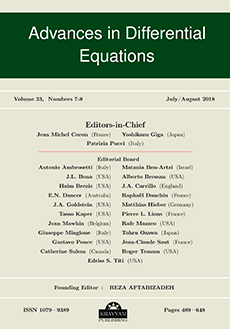Abstract
The renormalization (or averaging) procedure is often used to construct approximate solutions in evolutionary problems with multiple timescales arising from a small parameter $\varepsilon$. We show in this paper that the leading-order approximation shares two important properties of the original system, namely energy conservation in the inviscid case and dissipation rate (coercivity) in the forced--dissipative case. This implies the boundedness of the solutions of the renormalized (approximate) equation. In the dissipative case, we also investigate the higher-order renormalized equations, pursuing [16]: in particular, we show for sufficiently small $\varepsilon$ that the solutions of these equations are bounded and that the dissipativity property of the original system carries over in a modified form. This is shown by a simple estimate based on the above leading-order result, and, alternatively, by a "shadowing" argument.
Citation
R. M. Temam. D. Wirosoetisno. "On the solutions of the renormalized equations at all orders." Adv. Differential Equations 8 (8) 1005 - 1024, 2003. https://doi.org/10.57262/ade/1355926590
Information





